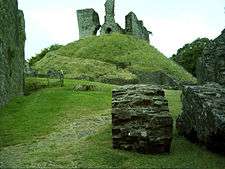Baldwin FitzGilbert
Baldwin FitzGilbert (died 1086-1091) (alias Baldwin the Sheriff, Baldwin of Exeter, Baldwin de Meulles/Moels and Baldwin du Sap) was a Norman magnate and one of the 52 Devon Domesday Book tenants-in-chief of King William the Conqueror, of whom he held the largest fiefdom in Devon, comprising 176 holdings or manors. He was feudal baron of Okehampton,[1] seated at Okehampton Castle in Devon.

Origins
He was originally from Meulles or nearby Le Sap, in Calvados, Normandy. He was a younger son of Gilbert, Count of Brionne and of Eu, in Normandy.
Career
Together with his eldest brother Richard FitzGilbert, in 1066 Baldwin accompanied William Duke of Normandy in the Norman Conquest of England.[2]
Following William the Conqueror's successful siege of the Saxon city of Exeter, that king appointed Baldwin castellan of the newly built Rougemont Castle in Exeter, a royal castle, and appointed him hereditary Sheriff of Devon, which position he held until his death. Exeter Castle was thenceforth the official seat of the Sheriff of Devon. King William I also granted him the very large feudal barony of Okehampton in Devon, at the caput of which he built Okehampton Castle.
English landholdings
Baldwin's fiefdom in Devon was the largest in that county,[3] listed in the Domesday Book of 1086 as comprising 176 holdings, mostly manors or estates, except the first two listed holdings which consisted of groups of houses in Exeter and Barnstaple.[4] He is listed in the Domesday Book as "Baldvinus Vicecomes", literally translated as "Baldwin the Viscount", a Norman title signifying deputy to the Count of Devon, another Norman title called in the Anglo-Saxon language "Earl of Devon", which office was almost synonymous with the Sheriff of Devon, an Anglo-Saxon office, for which reason Baldwin is commonly known as "Baldwin the Sheriff".[5] These landholdings comprised the feudal barony of Okehampton, later held by the Courtenay family, later also feudal barons of Plympton and Earls of Devon.
Marriage and children
His first wife was named Albreda, whom Orderic Vitalis refers to as a daughter of the aunt of William the Conqueror, presumably niece of his mother Herleva. In the Domesday Book, his wife appears as Emma.[6] He had three sons who all died childless, and two daughters:[6]
- Robert FitzBaldwin, Baldwin's heir in Normandy.
- William FitzBaldwin, inherited Baldwin's English lands.
- Richard FitzBaldwin.
- Adeliza FitzBaldwin, heiress to her three brothers, died childless.
- (? Matilda) FitzBaldwin, wife successively of William fitzWimund and Ranulf Avenel. William fitzWimund is listed in the Domesday Book of 1086 as holding land at Dolton, Devon in North Tawton Hundred, from his father-in-law Baldwin.[6]
Baldwin also had an illegitimate child, Wiger, a monk at Bec.[6]
Death and succession
Baldwin was living in 1086. He had died by 1091 according to Orderic.[7] Following the deaths of his three sons without heirs, his daughter Adeliza was his ultimate sole heiress.
Notes
- Sanders, I.J. English Baronies: A Study of their Origin and Descent 1086-1327, Oxford, 1960, p.69
- William Rufus (1983), p. 162, confirming his father and brother
- Thorn & Thorn, part 2 (notes), chap.16
- Thorn, Caroline & Frank, (eds.) Domesday Book, (Morris, John, gen.ed.) Vol. 9, Devon, Parts 1 & 2, Phillimore Press, Chichester, 1985, part 1, chapter 16: 1-176
- The heading at the start of the listing of his Devon lands is Terra(e) Baldvini Vicecomitis ("lands of Baldwin the Viscount" (genitive case))
- Keats-Rohan, K. S. B. (1999). Domesday People: A Prosopography of Persons Occurring in English Documents, 1066–1166: Domesday Book. Ipswich, UK: Boydell Press. p. 162. ISBN 9780851157221.
- Ormerod, George, 1861, "Descent of the Anglo-Norman Lords of Strugil", Strigulensia: Archæological Memoirs Relating to the District Adjacent to the Confluence of the Severne and the Wye , pp. 62-63, citing Ordericus